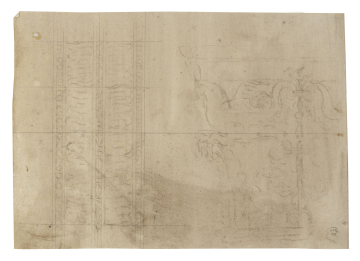
Browse
Reference number
Purpose
Aspect
Signed and dated
- Undated, probably 1762/63
Medium and dimensions
205 x 293
Hand
Notes
James Adam described this capital in 1762 as follows: 'Lions and unicorns alternately support the angles of the abacus, sustaining themselves on the acanthus leaves, their hinder parts, converted into chimeras, form twenty stalks that produce roses and thistles. The middle of the capital is adorned with a sceptre bearing the dove (the emblem of peace), over it the crown of Britain, instead of the Corinthian rose, and on the under part or moulding of the abbacus is the collar of the Order of the Garter. This capital is modelled in wax and bronzed and has altogether the air antique, and has surprised everybody that has seen it...' (see J. Fleming, Robert Adam and His Circle in Edinburgh & Rome, London, 1962, p.306). An explanation of the order was intended for Sir James Gray (c.1708-1773) but never written (see Adam vol.7/191 verso). In the Clerk Collection, Scotland there are two draughts for the dedication to the King: 'Description of my Capital 1762. This British order invented at Rome by JA. Archt. & intended for principal portico of a parliament house design'd by him at Rome 1762 most humbly presented to H.M. The king by his subject & servt the Author' (see J. Harris, Catalogue of British Drawings for Architecture, Decoration, Sculpture and Landscape Gardening, 1550-1900 in American Collections, New Jersey, 1971, p.3). There is also a chalk sketch for a similar order in Adam vol.7/13, and a version of this drawing, also by Antonio Zucchi (1726-95), in Prints and Drawings, Metropolitan Museum, New York, USA and another one in the Avery Library, Columbia University, USA (see Harris, op. cit., p.3).
The capital was also engraved in Rome by Domenico Cunego (1727(9) - 94) for The Works in Architecture of Robert and James Adam, London, 1773-79, part V, pl.2, as after James Adam, 1767: 'We have formerly, that the ancients used very frequently to indulge themselves in compositions of fancy; introducing into their capitals and entablatures the various symbols of those divinities to whom they erected temples. A licence of the same has been hazarded here. The lion and unicorn support the angles of the abacus, which is adorned with the regal crown, the collar of the order of the Garter, and acorns in ovolo. The sceptre and dove, the rose and thistle, fill the intermediate space between the leaves of the acanthus. The lion and unicorn are also alternatively interwoven in the foliage of the freeze, and the oak-leaf and acorn again adorn the upper torus of the base.'
James Adam intended the capital for the columns of the portico of his Parliament House scheme, and he referred to them in 1762 as 'for the great portico of my project' (see National Archives of Scotland, Edinburgh, Clerk of Penicuik Collection, GD18/4936). Giovanni Battista Piranesi (1720-1778), in his Trofei di Ottarviano Augusto, 1753, offered several antique sources for such a composition, especially that of San Lorenz fuori delle Mura. The capital also appears in the portrait of James Adam of 1763 by Antonio Zucchi (1726-95).
Level
Sir John Soane's collection includes some 30,000 architectural, design and topographical drawings which is a very important resource for scholars worldwide. His was the first architect’s collection to attempt to preserve the best in design for the architectural profession in the future, and it did so by assembling as exemplars surviving drawings by great Renaissance masters and by the leading architects in Britain in the 17th and 18th centuries and his near contemporaries such as Sir William Chambers, Robert Adam and George Dance the Younger. These drawings sit side by side with 9,000 drawings in Soane’s own hand or those of the pupils in his office, covering his early work as a student, his time in Italy and the drawings produced in the course of his architectural practice from 1780 until the 1830s.
Browse (via the vertical menu to the left) and search results for Drawings include a mixture of Concise catalogue records – drawn from an outline list of the collection – and fuller records where drawings have been catalogued in more detail (an ongoing process).

